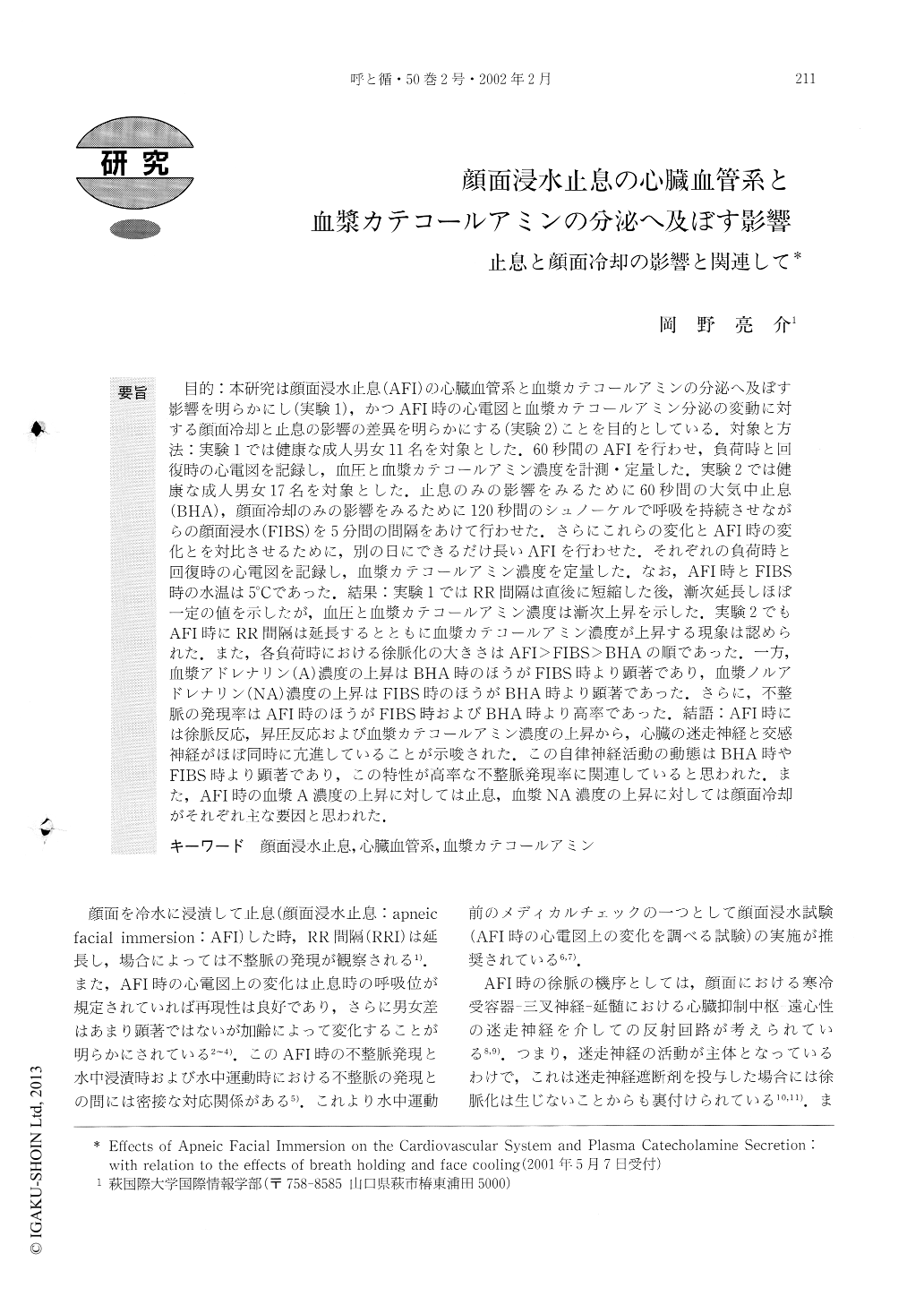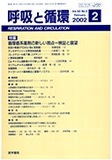Japanese
English
- 有料閲覧
- Abstract 文献概要
- 1ページ目 Look Inside
要旨 目的:本研究は顔面浸水止息(AFI)の心臓血管系と血漿カテコールアミンの分泌へ及ぼす影響を明らかにし(実験1),かつAFI時の心電図と血漿カテコールアミン分泌の変動に対する顔面冷却と止息の影響の差異を明らかにする(実験2)ことを目的としている.対象と方法:実験1では健康な成人男女11名を対象とした.60秒間のAFIを行わせ,負荷時と回復時の心電図を記録し,血圧と血漿カテコールアミン濃度を計測・定量した.実験2では健康な成人男女17名を対象とした.止息のみの影響をみるために60秒間の大気中止息(BHA),顔面冷却のみの影響をみるために120秒間のシュノーケルで呼吸を持続させながらの顔面浸水(FIBS)を5分間の間隔をあけて行わせた.さらにこれらの変化とAFI時の変化とを対比させるために,別の日にできるだけ長いAFIを行わせた.それぞれの負荷時と回復時の心電図を記録し,血漿カテコールアミン濃度を定量した.なお,AFI時とFIBS時の水温は5℃であった.結果:実験1ではRR間隔は直後に短縮した後,漸次延長しほぼ一定の値を示したが,血圧と血漿カテコールアミン濃度は漸次上昇を示した.実験2でもAFI時にRR間隔は延長するとともに血漿カテコールアミン濃度が上昇する現象は認められた.また,各負荷時における徐脈化の大きさはAFI>FIBS>BHAの順であった.一方,血漿アドレナリン(A)濃度の上昇はBHA時のほうがFIBS時より顕著であり,血漿ノルアドレナリン(NA)濃度の上昇はFIBS時のほうがBHA時より顕著であった.さらに,不整脈の発現率はAFI時のほうがFIBS時およびBHA時より高率であった.結語:AFI時には徐脈反応,昇圧反応および血漿カテコールアミン濃度の上昇から,心臓の迷走神経と交感神経がほぼ同時に亢進していることが示唆された.この自律神経活動の動態はBHA時やFIBS時より顕著であり,この特性が高率な不整脈発現率に関連していると思われた.また,AFI時の血漿A濃度の上昇に対しては止息,血漿NA濃度の上昇に対しては顔面冷却がそれぞれ主な要因と思われた.
This study examined the effects of apneic facial immersion (AFI) on the cardiovascular system and plasma catecholamine secretion (experiment 1) and compared the effects of breath holding in air (BHA), facial immersion breathing through a snorkel (FIBS) and AFI on electrocardiographic variations and plasma catecholamine secretion (experiment 2). Eleven and seventeen healthy subjects of both genders partipated in experiment 1 and 2 respectively. RR interval remained prolonged following the initial shortening and prolongation, while blood pressure and plasma catecholamine concentration increased progressively during AFI at 5℃ water temperature. In addition the increase of plasma catecholamine concentration accompanied by the RR interval prolongation during AFI reproduced. The magnitude of bradycardia induced by AFI was greater than that induced by either BHA or FIBS at 5℃ water temperature. Although plasma catecholamine concentration increased due to BHA and FIBS, the increase of plasma adrenaline (A) concentration was greater in BHA than in FIBS, while the increase of plasma noradrenaline (NA) concentration was greater in FIBS than in BHA. Furthermore incidence rate of arrhythmias induced by AFI was greater than that induced by either BHA or FIBS. From these results, the following two points are suggested : 1) Cardiac vagus and sympathetic nerve activity is accelerated simultaneously during AFI and this feature of autonomic nerve activity is more prominent in AFI than in either BHA or FIBS, allowing a higher incidence rate of arrhythmias during AFI ; 2) Breath holding is the main factor resulting in the increase in plasma A concentration during AFI and face cooling is the main factor resulting in the increase in plasma NA concentration during AFI.

Copyright © 2002, Igaku-Shoin Ltd. All rights reserved.


